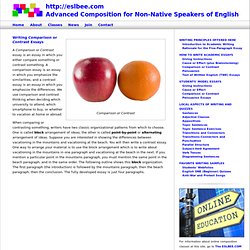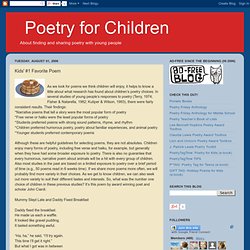

Orphan Trains. Student Materials: Comparison and Contrast Guide. Writing Comparison and Contrast Essays. Comparison or Contrast A Comparison or Contrast essay is an essay in which you either compare something or contrast something.

A comparison essay is an essay in which you emphasize the similarities, and a contrast essay is an essay in which you emphasize the differences. We use comparison and contrast thinking when deciding which university to attend, which smartphone to buy, or whether to vacation at home or abroad. When comparing or contrasting something, writers have two classic organizational patterns from which to choose. One is called block arrangement of ideas; the other is called point-by-point or alternating arrangement of ideas. A second way to organize this material is to discuss a particular point about vacationing in the mountains and then immediately to discuss the same point about vacationing at the beach.
What follows are two short essays, one illustrating block and the other illustrating point-by-point organization. Which Would YOU Prefer, and Why? A. B. Kids' #1 Favorite Poem. As we look for poems we think children will enjoy, it helps to know a little about what research has found about children’s poetry choices.

In several studies of young people’s responses to poetry (Terry, 1974; Fisher & Natarella, 1982; Kutiper & Wilson, 1993), there were fairly consistent results. Their findings: *Narrative poems that tell a story were the most popular form of poetry *Free verse or haiku were the least popular forms of poetry *Students preferred poems with strong sound patterns, rhyme, and rhythm *Children preferred humorous poetry, poetry about familiar experiences, and animal poetry *Younger students preferred contemporary poems Although these are helpful guidelines for selecting poems, they are not absolutes.
Children enjoy many forms of poetry, including free verse and haiku, for example, but generally when they have had some broader exposure to poetry. Mummy Slept Late and Daddy Fixed Breakfast “A little too well done? By John Ciardi. Fluency folders. Resource from LessonPlans.com – Lesson plans for teachers. Seasonal Haiku: Writing Poems to Celebrate Any Season. ReadWriteThink couldn't publish all of this great content without literacy experts to write and review for us.

If you've got lessons plans, activities, or other ideas you'd like to contribute, we'd love to hear from you. More Find the latest in professional publications, learn new techniques and strategies, and find out how you can connect with other literacy professionals. More Teacher Resources by Grade Your students can save their work with Student Interactives. More Home › Classroom Resources › Lesson Plans Lesson Plan Overview From Theory to Practice In this three-part lesson, students write and illustrate haiku depicting seasonal images. Back to top Haiku usually depict an image from nature rather than an action and facilitate the reader's reflection on nature.
This lesson inherently involves restrictions of convention that could hinder some students' creative use of descriptive language. Further Reading. Can You Haiku? Activity 1.

Reading Haiku Provide students with a selection of haiku from those available through the AskAsia website at Haiku by Basho and Haiku for People. Include both classic and contemporary examples in your selection. Have members of the class read each poem aloud and ask students to comment on similarities they notice among them. Through this discussion, help students recognize that haiku are: Very short: just three lines usually fewer than twenty syllables long.Descriptive: most haiku focus sharply on a detail of nature or everyday life.Personal: most haiku express a reaction to or reflection on what is described.Divided into two parts: as they read haiku aloud, students should find that each includes a turning point, often marked by a dash or colon, where the poet shifts from description to reflection, or shifts from close-up to a broader perspective.
Activity 2. Activity 3. Activity 4.
Word Development. Comprehension Strategies. Idioms Lesson. Projects.